OCZ Vertex 3 Pro Preview: The First SF-2500 SSD
by Anand Lal Shimpi on February 17, 2011 3:01 AM ESTAnandTech Storage Bench 2011: Much Heavier
I didn't expect to have to debut this so soon, but I've been working on updated benchmarks for 2011. Last year we introduced our AnandTech Storage Bench, a suite of benchmarks that took traces of real OS/application usage and played them back in a repeatable manner. I assembled the traces myself out of frustration with the majority of what we have today in terms of SSD benchmarks.
Although the AnandTech Storage Bench tests did a good job of characterizing SSD performance, they weren't stressful enough. All of the tests performed less than 10GB of reads/writes and typically involved only 4GB of writes specifically. That's not even enough exceed the spare area on most SSDs. Most canned SSD benchmarks don't even come close to writing a single gigabyte of data, but that doesn't mean that simply writing 4GB is acceptable.
Originally I kept the benchmarks short enough that they wouldn't be a burden to run (~30 minutes) but long enough that they were representative of what a power user might do with their system.
Not too long ago I tweeted that I had created what I referred to as the Mother of All SSD Benchmarks (MOASB). Rather than only writing 4GB of data to the drive, this benchmark writes 106.32GB. It's the load you'd put on a drive after nearly two weeks of constant usage. And it takes a *long* time to run.
I'll be sharing the full details of the benchmark in some upcoming SSD articles (again, I wasn't expecting to have to introduce this today so I'm a bit ill prepared) but here are some details:
1) The MOASB, officially called AnandTech Storage Bench 2011 - Heavy Workload, mainly focuses on the times when your I/O activity is the highest. There is a lot of downloading and application installing that happens during the course of this test. My thinking was that it's during application installs, file copies, downloading and multitasking with all of this that you can really notice performance differences between drives.
2) I tried to cover as many bases as possible with the software I incorporated into this test. There's a lot of photo editing in Photoshop, HTML editing in Dreamweaver, web browsing, game playing/level loading (Starcraft II & WoW are both a part of the test) as well as general use stuff (application installing, virus scanning). I included a large amount of email downloading, document creation and editing as well. To top it all off I even use Visual Studio 2008 to build Chromium during the test.
Many of you have asked for a better way to really characterize performance. Simply looking at IOPS doesn't really say much. As a result I'm going to be presenting Storage Bench 2011 data in a slightly different way. We'll have performance represented as Average MB/s, with higher numbers being better. At the same time I'll be reporting how long the SSD was busy while running this test. These disk busy graphs will show you exactly how much time was shaved off by using a faster drive vs. a slower one during the course of this test. Finally, I will also break out performance into reads, writes and combined. The reason I do this is to help balance out the fact that this test is unusually write intensive, which can often hide the benefits of a drive with good read performance.
There's also a new light workload for 2011. This is a far more reasonable, typical every day use case benchmark. Lots of web browsing, photo editing (but with a greater focus on photo consumption), video playback as well as some application installs and gaming. This test isn't nearly as write intensive as the MOASB but it's still multiple times more write intensive than what we were running last year.
As always I don't believe that these two benchmarks alone are enough to characterize the performance of a drive, but hopefully along with the rest of our tests they will help provide a better idea.
The testbed for Storage Bench 2011 has changed as well. We're now using a Sandy Bridge platform with full 6Gbps support for these tests. All of the older tests are still run on our X58 platform.
AnandTech Storage Bench 2011 - Heavy Workload
We'll start out by looking at average data rate throughout our new heavy workload test:
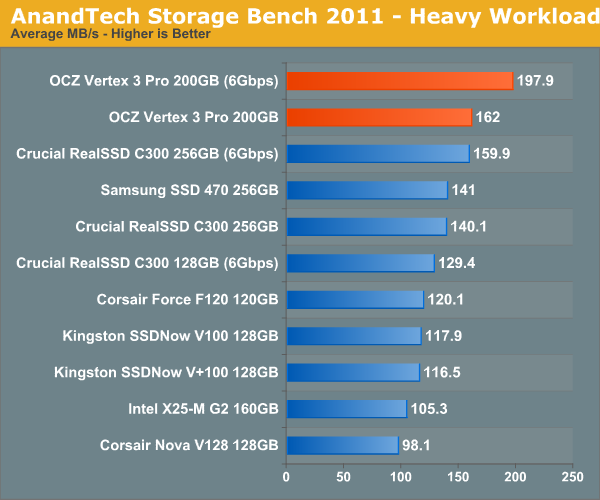
The Vertex 3 Pro on a 6Gbps interface is around 24% faster than Crucial's RealSSD C300. Note that the old SF-1200 (Corsair Force F120) can only deliver 60% of the speed of the new SF-2500. Over a 3Gbps interface the Vertex 3 Pro is quick, but only 15% faster than the next fastest 3Gbps drive. In order to get the most out of the SF-2500 you need a 6Gbps interface.
If we break out our performance results into average read and write speed we get a better idea for the Vertex 3 Pro's strengths:
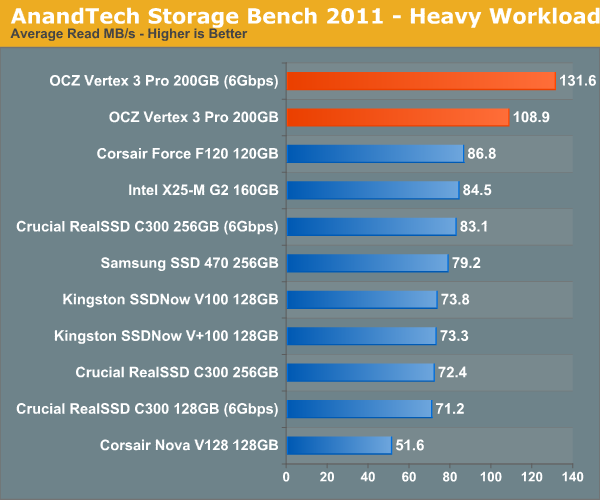
The SF-2500 is significantly faster than its predecessor and all other drives in terms of read performance. Good read speed is important as it influences application launch time as well as overall system responsiveness.
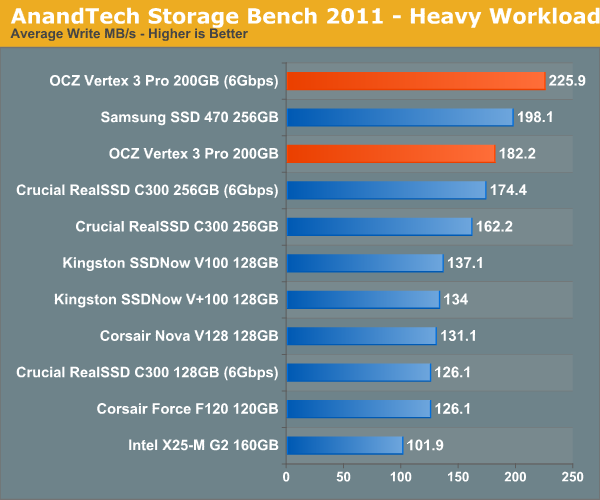
Average write speed is still class leading, but this benchmark uses a lot of incompressible data - you'll note that the Vertex 3 Pro only averages 225.9MB/s - barely over its worst case write speed. It's in this test that I'm expecting the new C400 to do better than SandForce.
The next three charts just represent the same data, but in a different manner. Instead of looking at average data rate, we're looking at how long the disk was busy for during this entire test. Note that disk busy time excludes any and all idles, this is just how long the SSD was busy doing something:
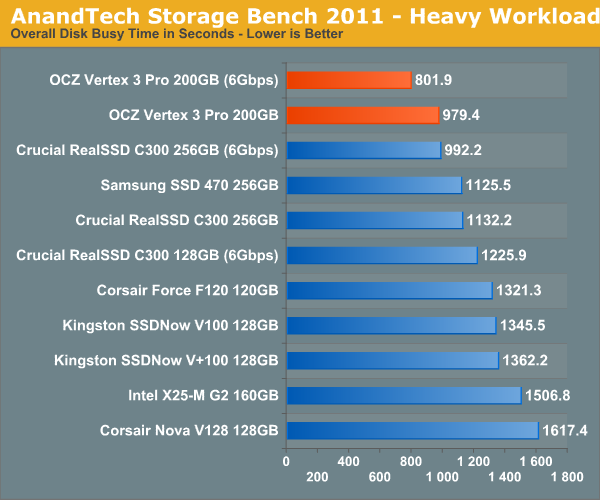
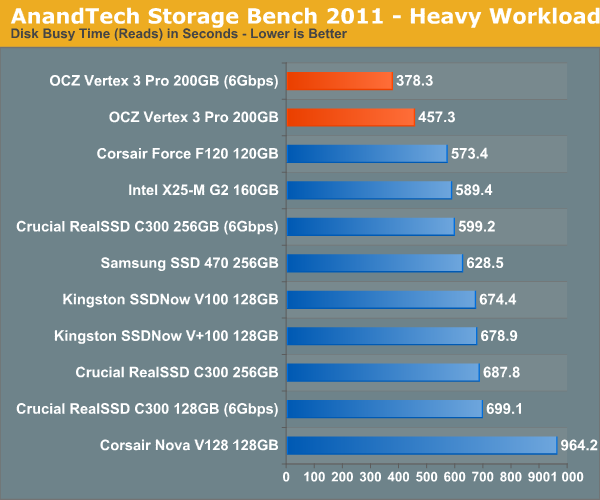


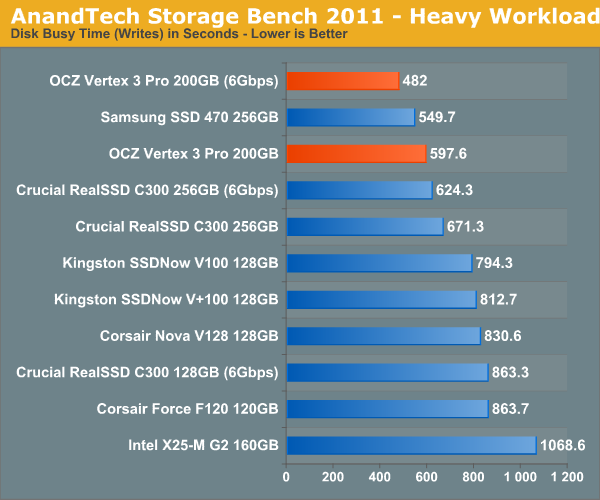








144 Comments
View All Comments
sheh - Thursday, February 17, 2011 - link
Why's data retention down from 10 years to 1 year as the rewrite limit is approached?Does this mean after half the rewrites the retention is down to 5 years?
What happens after that year, random errors?
Is there drive logic (or standard software) to "refresh" a drive?
AnnihilatorX - Saturday, February 19, 2011 - link
Think about how Flash cell works. There is a thick Silicon Dixoide barrier separating the floating gate with the transistor. The reason they have a limited write cycle is because the Silion dioxide layer is eroded when high voltages are required to pump electrons to the floating gate.As the SO2 is damaged, it is easier for the electrons in the floating gate to leak, eventually when sufficient charge is leaked the data is loss (flipped from 1 to 0)
bam-bam - Thursday, February 17, 2011 - link
Thanks for the great preview! Can’t wait to get a couple of these new SDD’s soon.I’ll add them to an even more anxiously-awaited high-end SATA-III RAID Controller (Adaptec 6805) which is due out in March 2011. I’ll run them in RAID-0 and then see how they compare to my current set up:
Two (2) Corsair P256 SSD's attached to an Adaptec 5805 controller in RAID-0 with the most current Windows 7 64-bit drivers. I’m still getting great numbers with these drives, almost a year into heavy, daily use. The proof is in pudding:
http://img24.imageshack.us/img24/6361/2172011atto....
(1500+ MB/s read speeds ain’t too bad for SATA-II based SSD’s, right?)
With my never-ending and completely insatiable need-for-speed, I can’t wait to see what these new SATA-III drives with the new Sand-Force controller and a (good-quality) RAID card will achieve!
Quindor - Friday, February 18, 2011 - link
Eeehrmm.....Please re-evaluatue what you have written above and how to preform benchmarks.
I too own a Adaptec 5805 and it has 512MB of cache memory. So, if you run atto with a size of 256MB, this fits inside the memory cache. You should see performance of around 1600MB/sec from the memory cache, this is in no way related to what your subsystem storage can or cannot do. A single disk connected to it but just using cache will give you exactly the same values.
Please rerun your tests set to 2GB and you will get real-world results of what the storage behind the card can do.
Actually, I'm a bit surprised that your writes don't get the same values? Maybe you don't have your write cache set to write back mode? This will improve performance even more, but consider using a UPS or a battery backup cache module before doing so. Same thing goes for allowing disk cache or not. Not sure if this settings will affect your SSD's though.
Please, analyze your results if they are even possible before believing them. Each port can do around 300MB/sec, so 2x300MB/sec =/= 1500MB/sec that should have been your first clue. ;)
mscommerce - Thursday, February 17, 2011 - link
Super comprehensible and easy to digest. I think its one of your best, Anand. Well done!semo - Friday, February 18, 2011 - link
"if you don't have a good 6Gbps interface (think Intel 6-series or AMD 8-series) then you probably should wait and upgrade your motherboard first""Whenever you Sandy Bridge owners get replacement motherboards, this may be the SSD you'll want to pair with them"
So I gather AMD haven't been able to fix their SATA III performance issues. Was it ever discovered what the problem is?
HangFire - Friday, February 18, 2011 - link
The wording is confusing, but I took that to mean you're OK with Intel 6 or AMD 8.Unfortunately, we may never know, as Anand rarely reads past page 4 or 5 of the comments.
I am getting expected performance from my C300 + 890GX.
HangFire - Friday, February 18, 2011 - link
OK here's the conclusion from 3/25/2010 SSD/Sata III article:"We have to give AMD credit here. Its platform group has clearly done the right thing. By switching to PCIe 2.0 completely and enabling 6Gbps SATA today, its platforms won’t be a bottleneck for any early adopters of fast SSDs. For Intel these issues don't go away until 2011 with the 6-series chipsets (Cougar Point) which will at least enable 6Gbps SATA. "
So, I think he is associating "good 6Gbps interface) with 6&8 series, not "don't have" with 6&8.
semo - Friday, February 18, 2011 - link
Ok I think I get it thanks HangFire. I remember that there was an article on Anandtech that tested SSDs on AMD's chipsets and the results weren't as good as Intel's. I've been waiting ever since for a follow up article but AMD stuff doesn't get much attention these days.BanditWorks - Friday, February 18, 2011 - link
So if MLC NAND mortality rate ("endurance") dropped from 10,000 cycles down to 5,000 with the transition to 34nm manufacturing tech., does that mean that the SLC NAND mortality rate of 100,000 cycles went down to ~ 50,000?Sorry if this seems like a stupid question. *_*